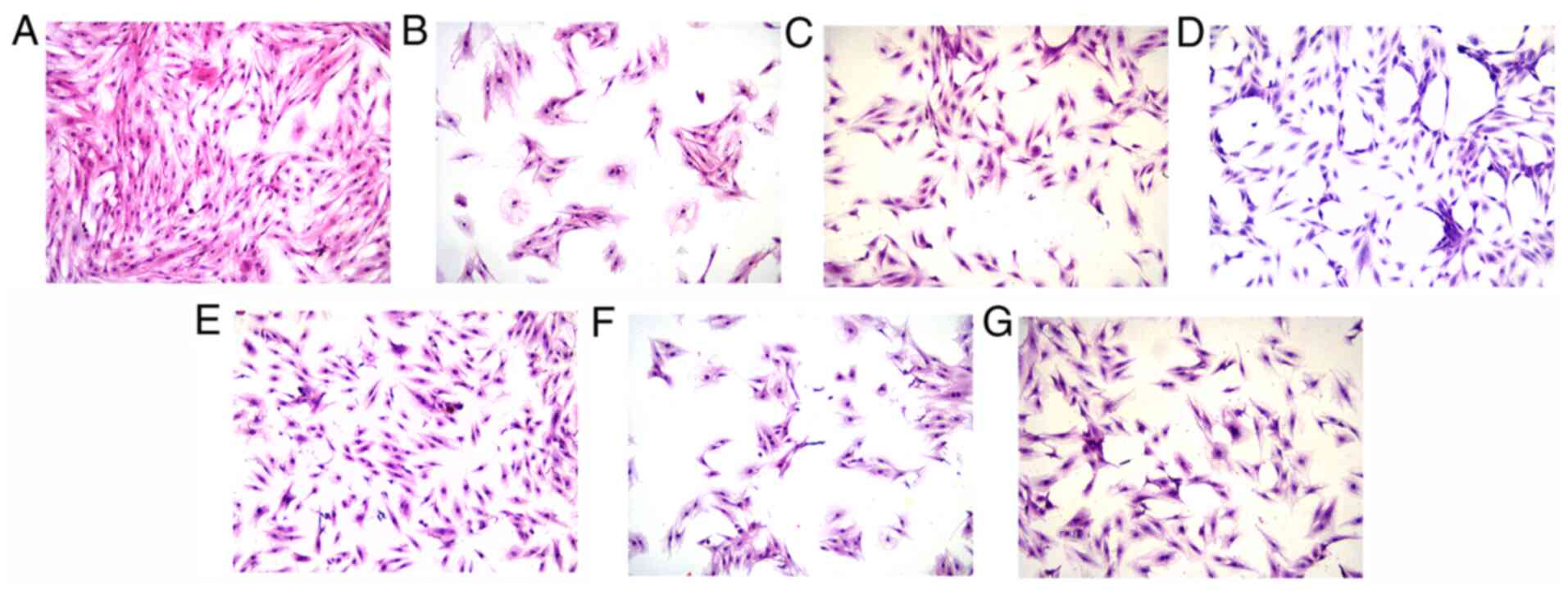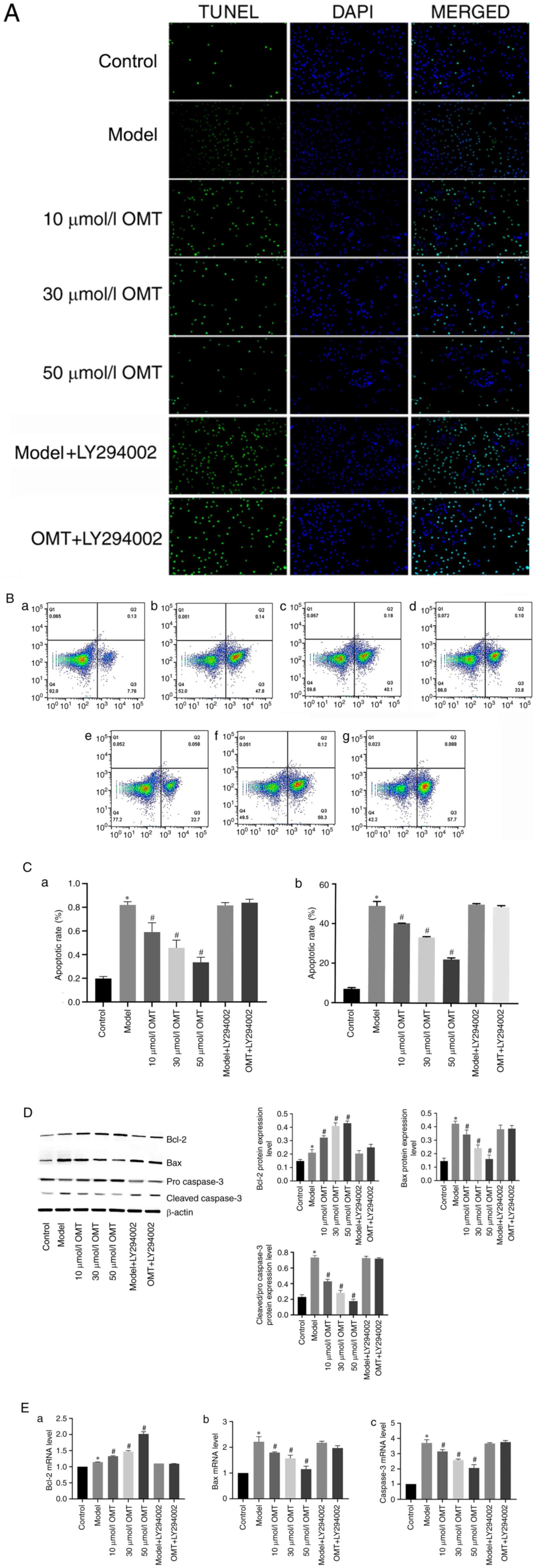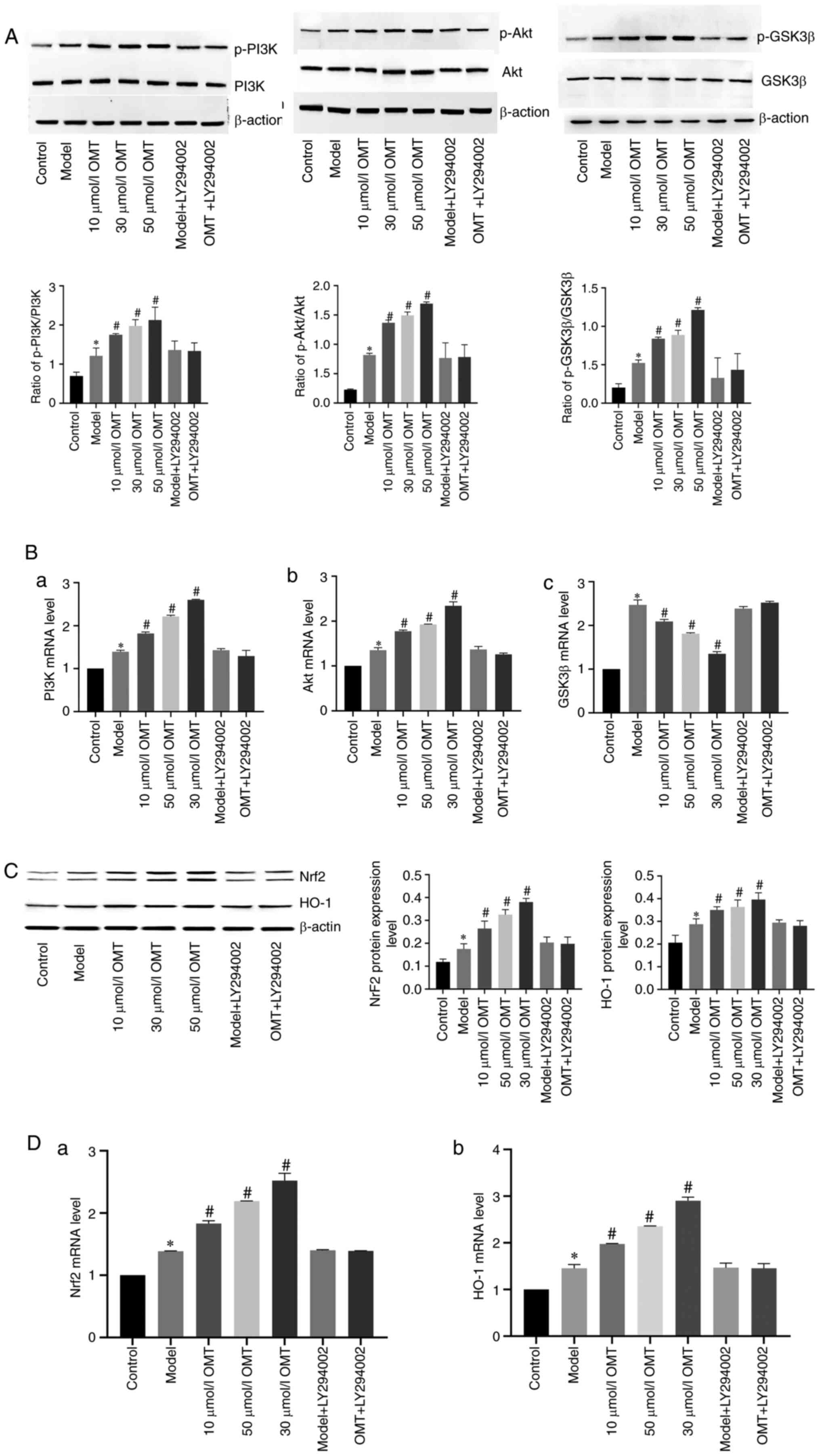|
1
|
Hausenloy DJ, Boston-Griffiths E and
Yellon DM: Cardioprotection during cardiac surgery. Cardiovasc Res.
94:253–265. 2012.PubMed/NCBI View Article : Google Scholar
|
|
2
|
Yellon DM and Hausenloy DJ: Myocardial
reperfusion injury. New Engl J Med. 357:1121–1135. 2007.PubMed/NCBI View Article : Google Scholar
|
|
3
|
Ma HJ, Li Q, Ma HJ, Guan Y, Shi M, Yang J,
Li DP and Zhang Y: Chronic intermittent hypobaric hypoxia
ameliorates ischemia/reperfusion-induced calcium overload in heart
via Na/Ca2+ exchanger in developing rats. Cell Physiol
Biochem. 34:313–324. 2014.PubMed/NCBI View Article : Google Scholar
|
|
4
|
Konstantinidis K, Whelan RS and Kitsis RN:
Mechanisms of cell death in heart disease. Arterioscler Thromb Vasc
Biol. 32:1552–1562. 2012.PubMed/NCBI View Article : Google Scholar
|
|
5
|
Lee S, Kim K, Kim YH, Chung MH, Kang I, Ha
J and Choe W: Preventive role of propofol in
hypoxia/reoxygenation-induced apoptotic H9c2 rat cardiac myoblast
cell death. Mol Med Rep. 4:351–356. 2011.PubMed/NCBI View Article : Google Scholar
|
|
6
|
Chai NL, Fu Q, Shi H, Cai CH, Wan J, Xu SP
and Wu BY: Oxymatrine liposome attenuates hepatic fibrosis via
targeting hepatic stellate cells. World J Gastroenterol.
18:4199–4206. 2012.PubMed/NCBI View Article : Google Scholar
|
|
7
|
Dong XQ, Du Q, Yu WH, Zhang ZY, Zhu Q, Che
ZH, Chen F, Wang H and Chen J: Anti-inflammatory effects of
oxymatrine through inhibition of nuclear factor-kappa B and
mitogen-activated protein kinase activation in
lipopolysaccharide-induced BV2 microglia cells. Iran J Pharm Res.
12:165–174. 2013.PubMed/NCBI
|
|
8
|
Ye J, Zou µM, Li P, Lin XJ, Jiang QW, Yang
Y, Huang JR, Yuan ML, Xing ZH and Wei MN: Oxymatrine and cisplatin
synergistically enhance anti-tumor immunity of CD8(+) T cells in
non-small cell lung cancer. Front Oncol. 8(631)2018.PubMed/NCBI View Article : Google Scholar
|
|
9
|
Cao YG, Jing S, Li L, Gao JQ, Shen ZY, Liu
Y, Xing Y, Wu ML, Wang Y and Xu CQ: Antiarrhythmic effects and
ionic mechanisms of oxymatrine from Sophora flavescens.
Phytother Res. 24:1844–1849. 2010.PubMed/NCBI View
Article : Google Scholar
|
|
10
|
Zhang M, Wang X, Wang X, Hou X, Teng P,
Jiang Y, Zhang L, Yang X, Tian J and Li G: Oxymatrine protects
against myocardial injury via inhibition of JAK2/STAT3 signaling in
rat septic shock. Mol Med Rep. 7:1293–1299. 2013.PubMed/NCBI View Article : Google Scholar
|
|
11
|
Dai G, Li B, Xu Y, Zeng Z and Yang H:
Oxymatrine prevents the development of monocrotaline-induced
pulmonary hypertension via regulation of the N(G),
N(G)-dimethyl-L-arginine metabolism pathways in rats. Eur J
Pharmacol. 842:338–344. 2019.PubMed/NCBI View Article : Google Scholar
|
|
12
|
Ge XH, Shao L and Zhu GJ: Oxymatrine
attenuates brain hypoxic-ischemic injury from apoptosis and
oxidative stress: Role of p-Akt/ GSK3β//HO-1/Nrf-2 signaling
pathway. Metab Brain Dis. 33:1869–1875. 2018.PubMed/NCBI View Article : Google Scholar
|
|
13
|
Li M, Zhang X, Cui L, Yang R, Wang L, Liu
L and Du W: The neuroprotection of oxymatrine in cerebral
ischemia/reperfusion is related to nuclear factor erythroid
2-related factor 2 (nrf2)-mediated antioxidant response: Role of
nrf2 and hemeoxygenase-1 expression. Biol Pharm Bull. 34:595–601.
2011.PubMed/NCBI View Article : Google Scholar
|
|
14
|
Liu Y, Wang H, Liu N, Du J, Lan XB, Qi X,
Zhuang CL, Sun T, Li YX and Yu JQ: Oxymatrine protects neonatal rat
against hypoxic-ischemic brain damage via PI3K/Akt/GSK3β pathway.
Life Sci. 254(116444)2020.PubMed/NCBI View Article : Google Scholar
|
|
15
|
Zhao TT, Yang TL, Gong L and Wu P:
Isorhamnetin protects against hypoxia/reoxygenation-induced injure
by attenuating apoptosis and oxidative stress in H9c2
cardiomyocytes. Gene. 666:92–99. 2018.PubMed/NCBI View Article : Google Scholar
|
|
16
|
Min J and Wei C: Hydroxysafflor yellow A
cardioprotection in ischemia-reperfusion (I/R) injury mainly via
Akt/hexokinase II independent of ERK/GSK-3β pathway. Biomed
Pharmacother. 87:419–426. 2017.PubMed/NCBI View Article : Google Scholar
|
|
17
|
Meng Y, Li WZ, Shi YW, Zhou BF, Ma R and
Li WP: Danshensu protects against ischemia/reperfusion injury and
inhibits the apoptosis of H9c2 cells by reducing the calcium
overload through the p-JNK-NF-κB-TRPC6 pathway. Int J Mol Med.
37:258–266. 2016.PubMed/NCBI View Article : Google Scholar
|
|
18
|
Livak KJ and Schmittgen TD: Analysis of
relative gene expression data using real-time quantitative PCR and
the 2-(-Delta Delta C(T) method. Methods. 25:402–408.
2001.PubMed/NCBI View Article : Google Scholar
|
|
19
|
Kingstone L, Currie GM and Torres C: The
pathogenesis, analysis, and imaging methods of atherosclerotic
disease of the carotid artery: Review of the literature. J Med
Imaging Radiat Sci. 43:84–94. 2012.PubMed/NCBI View Article : Google Scholar
|
|
20
|
Tong G, von Garlen NNA, Wowro SJ, Lam PD,
Krech J, Berger F and Schmitt KRL: Post-TTM rebound pyrexia after
ischemia-reperfusion injury results in sterile inflammation and
apoptosis in cardiomyocytes. Mediators Inflamm.
2019(6431957)2019.PubMed/NCBI View Article : Google Scholar
|
|
21
|
Ilmarinen P, Moilanen E and Kankaanranta
H: Mitochondria in the center of human eosinophil apoptosis and
survival. Int J Mol Sci. 15:3952–3969. 2014.PubMed/NCBI View Article : Google Scholar
|
|
22
|
Sun HL, Lei L, Lei S, Dan Z, De-Li D,
Guo-Fen Q, Yan L, Wen-Feng C and Bao-Feng Y: Cardioprotective
effects and underlying mechanisms of oxymatrine against Ischemic
myocardial injuries of rats. Phytother Res. 22:985–989.
2008.PubMed/NCBI View
Article : Google Scholar
|
|
23
|
Li T, Chen L, Yu Y, Yang B, Li P and Tan
XQ: Resveratrol alleviates hypoxia/reoxygenation injuryinduced
mitochondrial oxidative stress in cardiomyocytes. Mol Med Rep.
19:2774–2780. 2019.PubMed/NCBI View Article : Google Scholar
|
|
24
|
Sung HK, Song E, Jahng JWS, Pantopoulos K
and Sweeney G: Iron induces insulin resistance in cardiomyocytes
via regulation of oxidative stress. Sci Rep. 9(4668)2019.PubMed/NCBI View Article : Google Scholar
|
|
25
|
Heusch G, Libby P, Gersh B, Yellon D, Bohm
M, Lopaschuk G and Opie L: Cardiovascular remodelling in coronary
artery disease and heart failure. Lancet. 383:1933–1943.
2014.PubMed/NCBI View Article : Google Scholar
|
|
26
|
Dai DF, Chiao YA, Marcinek DJ, Szeto HH
and Rabinovitch PS: Mitochondrial oxidative stress in aging and
healthspan. Longev Healthspan. 6(3)2014.PubMed/NCBI View Article : Google Scholar
|
|
27
|
Wang Y, Che J, Zhao H, Tang J and Shi G:
Platycodin D inhibits oxidative stress and apoptosis in H9c2
cardiomyocytes following hypoxia/reoxygenation injury. Biochem
Biophys Res Commun. 503:3219–3224. 2018.PubMed/NCBI View Article : Google Scholar
|
|
28
|
Kansanen E, Kuosmanen SM, Leinonen H and
Levonen AL: The Keap1-Nrf2 pathway: Mechanisms of activation and
dysregulation in cancer. Redox Biol. 1:45–49. 2013.PubMed/NCBI View Article : Google Scholar
|
|
29
|
Fan J, Xu G, Jiang T and Qin Y:
Pharmacologic induction of heme oxygenase-1 plays a protective role
in diabetic retinopathy in rats. Invest Ophthalmol Vis Sci.
53:6541–6556. 2012.PubMed/NCBI View Article : Google Scholar
|
|
30
|
Wang D, Zhang X, Li D, Hao W, Meng F, Wang
B, Han J and Zheng Q: Kaempferide protects against myocardial
ischemia/reperfusion injury through activation of the
PI3K/Akt/GSK-3beta pathway. Mediators Inflamm.
2017(5278218)2017.PubMed/NCBI View Article : Google Scholar
|
|
31
|
Xu L, Jiang X, Wei F and Zhu H: Leonurine
protects cardiac function following acute myocardial infarction
through antiapoptosis by the PI3K/AKT/GSK3β signaling pathway. Mol
Med Rep. 18:1582–1590. 2018.PubMed/NCBI View Article : Google Scholar
|
|
32
|
Tang Q, Zheng X and Zhang J: Long
non-coding RNA CRNDE promotes heptaocellular carcinoma cell
proliferation by regulating PI3K/Akt/β-catenin signaling. Biomed
Pharmacother. 103:1187–1193. 2018.PubMed/NCBI View Article : Google Scholar
|
|
33
|
Buja LM: Myocardial ischemia and
reperfusion injury. Cardiovasc Pathol. 14:170–175. 2005.PubMed/NCBI View Article : Google Scholar
|
|
34
|
Zhao Q, Li H, Chang L, Wei C, Yin Y, Bei
H, Wang Z, Liang J and Wu Y: Qiliqiangxin attenuates oxidative
stress-induced mitochondrion-dependent apoptosis in cardiomyocytes
via PI3K/AKT/GSK3β signaling pathway. Biol Pharm Bull.
42:1310–1321. 2019.PubMed/NCBI View Article : Google Scholar
|
|
35
|
Bhat RV, Shanley J, Correll MP, Fieles WE,
Keith RA, Scott CW and Lee CM: Regulation and localization of
tyrosine216 phosphorylation of glycogen synthase kinase-3beta in
cellular and animal models of neuronal degeneration. Proc Natl Acad
Sci U S A. 97:11074–11079. 2000.PubMed/NCBI View Article : Google Scholar
|
|
36
|
Li X, Zhang J, Zhu X, Wang P, Wang X and
Li D: Progesterone reduces inflammation and apoptosis in neonatal
rats with hypoxic ischemic brain damage through the PI3K/Akt
pathway. Int J Clin Exp Med. 8:8197–8203. 2015.PubMed/NCBI
|
|
37
|
Xiao TT, Wang YY, Zhang Y, Bai CH and Shen
XC: Similar to spironolactone, oxymatrine is protective in
aldosterone-induced cardiomyocyte injury via inhibition of calpain
and apoptosis-inducing factor signaling. PLoS One.
9(e88856)2014.PubMed/NCBI View Article : Google Scholar
|
|
38
|
Javadov S, Hunter JC, Barreto-Torres G and
Parodi-Rullan R: Targeting the mitochondrial permeability
transition: Cardiac ischemia-reperfusion versus carcinogenesis.
Cell Physiol Biochem. 27:179–190. 2011.PubMed/NCBI View Article : Google Scholar
|
|
39
|
Liao YH, Xia N, Zhou SF, Tang TT, Yan XX,
Lv BJ, Nie SF, Wang J, Iwakura Y and Xiao H: Interleukin-17A
contributes to myocardial ischemia/reperfusion injury by regulating
cardiomyocyte apoptosis and neutrophil infiltration. J Am Coll
Cardiol. 59:420–429. 2012.PubMed/NCBI View Article : Google Scholar
|



















